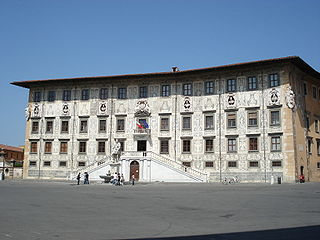
Palazzo della Carovana
Encyclopedia

Knights' Square (Pisa)
The Knights’ Square is one of the most important landmarks in Pisa, Italy, and the second main square of the city. This square was the political centre in medieval Pisa. After the middle of 16th century the square become the headquarters of the Order of the Knights of St...
, Pisa
Pisa
Pisa is a city in Tuscany, Central Italy, on the right bank of the mouth of the River Arno on the Tyrrhenian Sea. It is the capital city of the Province of Pisa...
, Italy
Italy
Italy , officially the Italian Republic languages]] under the European Charter for Regional or Minority Languages. In each of these, Italy's official name is as follows:;;;;;;;;), is a unitary parliamentary republic in South-Central Europe. To the north it borders France, Switzerland, Austria and...
, presently housing the Scuola Normale Superiore di Pisa
Scuola Normale Superiore di Pisa
The Scuola Normale Superiore di Pisa, also known in Italian as Scuola Normale , is a public higher learning institution in Italy. It was founded in 1810, by Napoleonic decree, as a branch of the École Normale Supérieure of Paris...
.
It was built in 1562–1564 by Giorgio Vasari
Giorgio Vasari
Giorgio Vasari was an Italian painter, writer, historian, and architect, who is famous today for his biographies of Italian artists, considered the ideological foundation of art-historical writing.-Biography:...
for the headquarters of the Knights of St. Stephen, as a renovation of the already existing Palazzo degli Anziani ("Palace of the Elders"). The name, meaning "Palace of the Convoy", derives from the three year period undertaken by the initiates of the Order for their training, called "la Carovana".
The façade is characterized by a complex scheme with sgraffiti
Sgraffito
Sgraffito is a technique either of wall decor, produced by applying layers of plaster tinted in contrasting colors to a moistened surface, or in ceramics, by applying to an unfired ceramic body two successive layers of contrasting slip, and then in either case scratching so as to produce an...
representing allegorical figures and zodiacal signs, designed by Vasari himself and sculpted by Tommaso di Battista del Verrocchio and Alessandro Forzori, coupled to busts and marble crests. The current paintings date however to the 19th-20th centuries.
Amongst the sculptures are the Medici Coat of Arms and that of the Knights, flanked by the allegories of Religion and Justice by Stoldo Lorenzi
Stoldo Lorenzi
Stoldo Lorenzi was an Italian Mannerist sculptor.Born at Settignano, he studied in Florence and was influenced by artists such as Giambologna and Tribolo. Lorenzi mostly executed bronze sculptures. His masterwork in Florence is considered the Fountain of Neptune in the Boboli Gardens .Later he...
(1563). The upper gallery of busts of the Grand Dukes of Tuscany were added in the late 16th-early 18th centuries, sculpted by Ridolfo Sirigatti, Pietro Tacca
Pietro Tacca
Pietro Tacca was an Italian sculptor, who was the chief pupil and follower of Giambologna. Tacca began in a Mannerist style and worked in the Baroque style during his maturity.-Biography:...
and Giovan Battista Foggini.
The double-ramp staircase was remade in 1821. The rear area is a modern addition (1928–1930) for the Scuola Normale di Pisa. Some halls of the interior house 16th century paintings.

